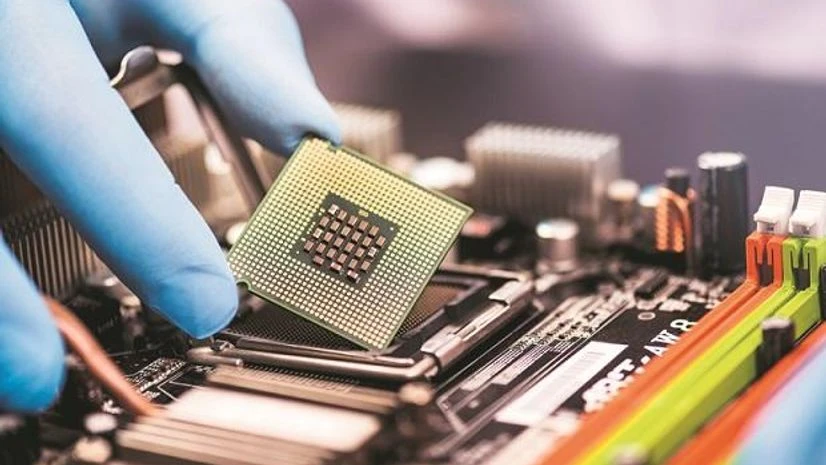In what could be a blow to India’s chip manufacturing ambition, Taiwanese major Foxconn has walked out of its joint venture with Anil Agarwal-led Vedanta group almost a year after signing a pact to set up a Rs 1.54-trillion facility in Gujarat. Following an MoU with the Gujarat government last September, the JV had announced earlier this year that a semiconductor and display manufacturing facility would be set up in the Dholera Special Investment Region, near Ahmedabad. This would have been India’s first semiconductor plant.
Manufacturing of semiconductors—essential components used in electronic devices for anything from communications to healthcare and transportation to military systems—has been in the limelight in the midst of a tech war between the US and China. While more than 90 per cent of the most advanced semiconductors are manufactured in Taiwan, the other countries making chips include South Korea, Japan, US and China.
Taiwanese major and the biggest chipmaker in the world, Foxconn, said in a statement on Monday that it had determined not to move forward on the joint venture with Vedanta. ‘’Foxconn is working to remove the Foxconn name from now what is a fully-owned entity by Vedanta.” Before Gujarat, Maharashtra was explored as a destination for Foxconn’s chip manufacturing plant.
The mining giant Vedanta group, which was in the news for the financial stress of its London-based entity Vedanta Resources, was quick to respond and assure investors that nothing was amiss. “Vedanta reiterates that it is fully committed to the semiconductor project and we have lined up other partners to set up the foundry,” the company said. It added that Vedanta had a licence for production grade 40 nanometre (nm) chips from a prominent integrated device manufacturer. It pointed out that it would ‘’shortly acquire a licence for production grade 28 nm as well”.
Communciations minister Ashwani Vaishnaw, who was present in Gandhinagar at the time of the MoU last September, did not express disappointment over the Foxconn-Vedanta JV breaking off. “Both companies have committed to India’s semiconductor story and therefore India’s story in chip making will not get impacted,” Vaishnaw said. Minister of State for Electronics and IT Rajeev Chandrasekhar tweeted that the Foxconn decision would have no impact on India’s semiconductor fabrication plant goal. ‘’None,’’ the minister reiterated.
Also Read
Sources tracking the development said that Foxconn could come on its own--a proposal which the Taiwanese major had discussed with top government officials recently. The reference was to an earlier statement of Foxconn global chairman and CEO Young Liu that the company would like to set up a second fab plant with or without government incentive.
Even so, analysts are looking at the latest development as a political setback both for the Centre and the Gujarat government. Prime Minister Narendra Modi had highlighted the significance of a mega semiconductor plant being put up by Foxconn and Vedanta at a rally in Bhavnagar ahead of the Gujarat Assembly election. Relying on the semiconductor plant, Gujarat chief minister Bhupendrabhai Patel had promised creating ‘’100,000 job opportunities’’. In fact, the Gujarat became the first state to come out with a semiconductor policy last year.
According to sources in the know, Foxconn, which consumes chips valued at $40 billion annually and is now getting into electric vehicles, had agreed to buy back a substantial portion of the 28 nm product under the JV.
The project went through numerous twists and turns. The JV decide to tweak its earlier proposal--just a few weeks ago – by including manufacturing of 40 nm chips-where technology is easily available…. Back and forth on technology negotiations also put things on hold. Apart from the tech challenges, the project was also getting delayed because of the financial stress of the Vedanta group to reduce its high debt, top sources said. And it was increasingly felt that the Taiwanese company was not bringing in much to the table--except some possible buy back of chips, they pointed out.
While Vedanta appears bullish, none of the three projects has received clearance from the India Semicondcutor Mission- the nodal body. Both Singapore- based IGSS and Dubai-based ISMC, which had a tie up with Tower Corporation for a $3-billion technology project, have been asked to give fresh proposals which they may. Tower has been acquired by Intel but it still awaits regulatory clearances.
There’s something to cheer as well in the chip story. India has been able to tie the knot with Micron, which has agreed to invest $285 million in a chip testing and packaging plant with the wafers being imported from its fab plants in other countries. Talks have also commenced on the possibility of them setting a fab plant for memory chips.

)
